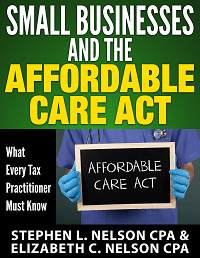 Last week Congress created the “Qualified Small Employer Health Reimbursement Arrangement.”
Last week Congress created the “Qualified Small Employer Health Reimbursement Arrangement.”
Presumably, President Obama will sign the legislation today or later this week.
And once that happens, small businesses will once again have an easy option (sort of) for providing health insurance for their employees.
Why Healthcare Reimbursement Arrangement Matters
Talking about the Affordable Care Act, better known as Obamacare, risks turning into a political argument. But putting politics aside (at least for the next twenty or so minutes), we think this new health insurance arrangement is a big deal for small businesses. And a real opportunity.
Here’s why: Obamacare created an expectation that employers will provide health insurance for employees. But at the same time, Obamacare unintentionally blew up the common, shortcut approach that small employers used for decades to provide insurance to their employees… which was to pay employees an amount (tax-free) that let them buy their own individual health insurance.
As discussed here, you could operate such a plan but the penalties were catastrophic.
How Qualified Small Employer Health Reimbursement Arrangement Works
The new law (text available here) sort of puts humpty-dumpty back together.
Specifically, starting in 2017, you can set up a plan, or an arrangement, where you reimburse for your employees’ individual health insurance as long as you carefully follow some rules that honor the spirit of Obamacare.
For example, the plan needs to be provided on the same terms to all “eligible employees” and you have to notify your employees that the plan exists.
Tip: You’ll want to really understand the employee non-discrimination rules before you set up your own health reimbursement arrangement. We’ve talked about these rules a bit in the past on our blog here (scroll down to old rule #2).
In addition, your business needs to be an “eligible employer.” This means the employer isn’t an “applicable large employer”, which is generally a business with 50 or more employees. (If your business is comfortably below 50 employees, you can have a qualified small employer health reimbursement arrangement. If you’re near the cutoff, however, ask a tax professional to help you sort through the rules.)
No salary reduction contributions are allowed; only the employer can contribute. Further, the plan can only reimburse employees for medical expenses as defined under IRC § 213(d). Medical expenses under this definition include health insurance, but also include out-of-pocket medical expenses. But the employee needs to prove to the employer that they have health insurance coverage before the employer can make any reimbursements.
In general, the employer cannot pay out more than $4,950 a year for an employee unless the plan also covers the employee’s family, in which case the employer cannot pay out more than $10,000 a year. Also, these amounts get prorated; for example, if an employee is only on the plan for 5 months of the year and they don’t have extra relatives to cover, then the annual limit is 5⁄12 × $4,950 = $2,062.50.
Finally, an employee needs to have minimum essential coverage in order for the reimbursements to be excludable from the employee’s income. (More on this in a minute.)
Qualified Small Employer Health Reimbursement Arrangement Effective Date
I said this earlier in passing, but just so it’s clear: An employer can offer a qualified small employer health reimbursement arrangement only for years starting after December 31, 2016.
A reimbursement arrangement doesn’t work retroactively for 2016, therefore.
And a related point: Because the new option is more complicated than simply writing a check, we think you need to move fast in order to have a plan in effect at the start of the new year.
Two Other Really Important Rules to Know
As we all learn more about the new law, we’ll uncover new details and surely get additional guidance. But two other important points to know from the very start.
A first really important rule I already mentioned: The insurance paid for through one of these arrangements needs to meet the Affordable Care Act’s “minimum essential coverage” threshold. “Minimum essential coverage” is defined in IRC § 5000A(f). It is the minimum amount of coverage that your employees will need to not be subject to the penalty for not having health insurance.
If your employee receives a reimbursement and they don’t have minimum essential coverage, you include the reimbursement amounts on their W-2. Practically speaking, this extra complication means that you’ll want to establish some way of verifying that your employees have individual health insurance throughout the whole year in order to avoid creating a payroll accounting mess for yourself.
And a second really important rule: You need to provide employees with a statement that both notifies them of their eligibility to participate in your plan and describes all of the information that their state’s exchange might need to calculate their eligibility for a premium tax credit. And just so you know, this premium tax credit comes into play if an employee needs to kick in more than 9.5% of their income to pay for the part of the health insurance premium that you (the employer) are not paying.
Need More Help with the Small Businesses and the Affordable Care Act?
If you’re a tax practitioner advising small business clients about how to navigate the treacherous waters of healthcare reform, you may be interested in our monograph, Small Businesses and the Affordable Care Act, which is available for $100 and which includes sample forms, client letters and handouts you can use for explaining the mechanics of the Affordable Care Act to your clients.
We think this short whitepaper (roughly 70 pages in length) should save tax practitioners several hours of learning time. For example, it describes the ACA issues that you need to understand for your small business clients in detail and is richly footnoted with hyperlinks to primary source authorities. The monograph also provides a boilerplate healthcare policy document practitioners can use for their clients, and it supplies example W-2 forms to show how these items should be prepared given the ACA. We’ve also included sample client letters and longer “handouts” you can use to communicate with clients.
The whitepaper includes coverage of the “Qualified Small Employer Health Reimbursement Arrangement” option created in December 2016 by the 21st Century Cures Act.
If you’re ready to buy you can use this button below. Or if you need more information, click here.
Money Back Guarantee
As with all of our publications, the Small Businesses and the Affordable Care Act (Obamacare) monograph comes with a money-back guarantee, so if you purchase it and then for whatever reason find it’s not what you need or what you expected, simply email us your refund request. We will happily issue you a refund, no questions and no hassles.

Taking care of the health of the employee is the must thing nowadays for the organizations. Thank you for sharing such an awesome article.
Do we know how this will affect S Corp shareholder employees? Will they be able to use a QSEHRA with full tax benefits including 213(d) out-of-pocket?
I think S corps can do their accounting for shareholder-employees the old “Notice 2008-1” way… or using QSEHRAs.
Would it be correct to interpret that you cannot pay insurance and an hra? Looks like either or for an s-corp shareholder?
Hi Eric, First, thanks for dropping by. Nice to hear from you.
Second, the way I read the law, I don’t think you can “double up”… I.e., you can reimburse up to the statutory limit things like insurance, out of pocket, etc. But I don’t think that if you “used up” that limit, that you can piggyback on another healthcare reimbursement arrangement.
FYI, I think you might be able to get a regular Sec. 105(b) plan (a regular healthcare reimbursement arrangement) to work as long as you avoided the booby traps that Obamacare creates. So maybe you can get where you want to be with just that. (Maybe you’ve got a single employee S corporation employing only the shareholder. Or a sole proprietorship that employs only one employee–the spouse of the proprietor.)